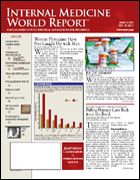Inadequate Glycemic Control Demonstrated in Chronic Insulin Users
Inadequate Glycemic Control Demonstrated in Chronic Insulin Users
Suspect Compliance Issues in Patients Not at Therapeutic Goals
By Jill Stein
Many adults with type 2 diabetes who are chronically prescribed a specific insulin regimen often use only about three quarters of their prescribed amounts of insulin, show results of a recent study (Diabetes Care. 2005:28:78-83).
As a consequence, such patients’ glycosylated hemoglobin (Hb A1C) values remain higher than recommended target levels for this patient population.
“The results suggest that insulin self-management [injection compliance], the prescribed regimen, or both were inadequate to achieve good glycemic control,” lead investigator Joyce A. Cramer, BS, MD, of Yale University School of Medicine, and colleagues wrote.
In this trial, the rate of insulin use was reviewed over a 2-year period in 6222 patients with diabetes (the majority of whom were aged ³65 years) from Veterans Administration medical facilities who were using chronic insulin therapy. Insulin dose was defined as the number of units and doses. Included in the study were patients who had received ³1 prescription for insulin between January 1 and July 1, 2001.
Patients used 77.44 ± 17% of doses prescribed, which included insulin wasted. Their mean Hb A1C levels were 7.98 ± 1.66%.
In addition, age, race, and insulin use were significant predictors of Hb A1C levels.
Results showed significantly higher insulin use among white patients compared with either black patients, Hispanic/other individuals, those with lower Hb A1C levels, or those with higher diabetes management intensity.
Of note, patients who had recently started using insulin because of increased Hb A1C levels adhered to their prescribed regimen better than chronic insulin users. The improved compliance level among new insulin users was speculated to be the result of their willingness to initiate insulin treatment to reduce their Hb A1C coupled with their conscientiousness in following “newly learned” injection methods, the investigators said.
They emphasized that the significant association between insulin use and Hb A1C bolsters the notion that regular dosing is important in order to achieve glycemic control.
“This report on compliance with insulin treatment is the first to demonstrate that people take far less insulin than expected when a specific regimen is prescribed,” Dr Cramer told IMWR. “Insulin regimen compliance is lower than for oral hypoglycemic agents. The clinical relevance of this finding is the association of poorer compliance with higher Hb A1C levels.”
Based on these findings, the investigators called for the development of improved methods or new devices to track the regularity and accuracy of insulin dosing and wastage as a first step toward identifying where interventions might be helpful. In addition, longitudinal insulin dose monitoring would clarify whether patients require additional instruction about syringe use or increased dosing to achieve their Hb A1C goal levels, the researchers said.
“The cost of care/medication was not an issue for these patients, so the poor diabetes control seems to be related both to inadequate patient dosing/self-management as well as inadequate attention by physicians who did not attempt to have their patients achieve guideline goals for lower Hb A1C levels,” Dr Cramer noted.
She added that although medicine is not practiced by guideline, the Hb A1C target is thought to prevent micro- and macro-vascular complications linked to high glucose levels.
